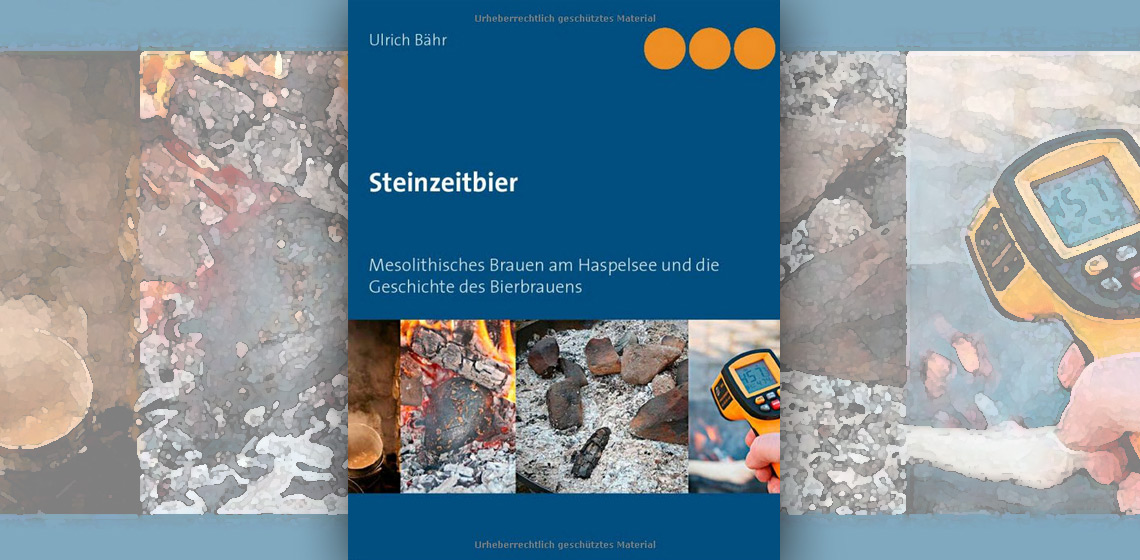
Did people in the Mesolithic period brew beer at Haspelmoor? How was the fermentation process started and how did they control the temperature of cooking stones? These and other questions regarding Stone Age brewing are answered in the new book published by Ulrich Bähr and a group of brewing enthusiasts from Germany. In 28 experiments, ‘Historischer Verein Fürstenfeldbruck’ addresses essential questions regarding brewing in the Mesolithic period.
Inspired by the cereal pollen finds at the Mesolithic site at Haspel lake in South Germany, the Historischer Verein Fürstenfeldbruck society started to conduct archaeological experiments in 2015. Following the hypotheses that cereals were cultivated at Haspelmoor around 6000 B.C., the main objective of the group was to investigate if brewing in the area would generally have been possible during this period.
The publication is 264 pages long and gives the reader not only insights into brewing in the Mesolithic period but an overall understanding of brewing techniques and brewing history in general. The author introduces the site at Haspelmoor with a special emphasis on the pollen analysis. To give the reader a better understanding of the history of brewing, the author then goes to great length to explain brewing techniques and gives a detailed historic overview from the Mesolithic period to modern times. The history of brewing in the Ancient Near East and Egypt, as well as traditional brewing techniques used in Central Africa, northern Namibia, and Europe today, are included in this overview.
The author then asks why the Mesolithic people wanted to drink beer in the first place. An easy enough question to answer for everybody who likes to enjoy a casual pint, but the important social aspect of drinking and feasting in ancient societies is worth discussing as well as the “beer before bread” theory. Both topics, as well as the aspect of nutrition, are considered in this chapter.
Beer in the Mesolithic period?
Then the main question is asked: Was it possible to brew beer in the Mesolithic period? To answer this question, the environmental conditions and requirements regarding techniques and resources in the Mesolithic period are discussed. The cereal available, as well as cultivation and harvesting techniques with Mesolithic tools are presented. Since microliths were found on a clay floor at Haspelmoor, the author suggests that the malt was dried on mats on the clay floor. He offers different ideas towards the malting and storing of malt, including the production of Caramalt and green malt. Several possible mashing methods that could have been used during the Mesolithic period such as the infusion process and raw ale production are introduced. Different materials available to produce mash tuns are suggested, such as textile, leather, birch bark, wood, and stone. Mashing with cooking stones is discussed in detail as a likely method for heating mash. Different rock types found at Haspelmoor are considered during the experiments and examined with regard to their heating qualities. Possible additives, such as hops and juniper, are briefly addressed but the author found no evidence for their use. Regarding the fermentation process, the author points out how many yeast strains have evolved until today, making it difficult to decide what kind of yeast might have been used in Mesolithic beer and how the beer tasted. A list of known yeasts is, however, provided by the author and the fermentation with fruit starters made of berries is proposed as one option for fermentation during the Mesolithic period.
Twenty-eight Experiments
The author’s thoughts on Mesolithic brewing at Haspelmoor are based on the experiments conducted by him and his team. Twenty-eight experiments and reconstructions give interesting insights into all aspects of Mesolithic brewing. The experiments include grain cultivation and harvesting, malting green malt and Caramalt, and mashing with and without hot stones. Furthermore, experiments on mashing and fermenting in a hollowed-out log, as well as research on the effects of additives and fermentation with fruit starters, are part of the experiments presented by Ulrich Bähr.
Book review: Conclusions
The publication is written in German and no English summary is included. The book contains many illustrations and pictures. Although the publication would have benefited from a professional editing and layout process, the book is highly recommended for beginners and open-air museum staff interested in recreating Stone Age beer and archaeological brewing experts alike. It gives a helpful overview of the history of brewing and the experiments are a valuable addition to the research conducted by the scientific community so far.
Book information:
Bähr, Ulrich (ed.), 2020. Steinzeitbier – Mesolithisches Brauen am Haspelsee und die Geschichte des Bierbrauens. BoD – Books on Demand, Norderstedt. 264 pages. ISBN 978-3-7519-2989-9